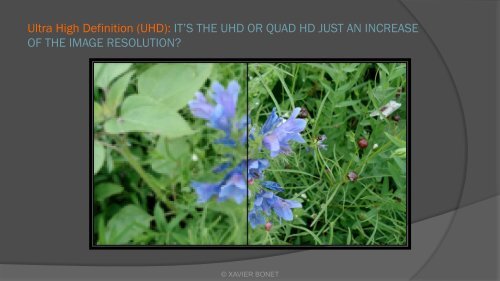boné_UHD
Create successful ePaper yourself
Turn your PDF publications into a flip-book with our unique Google optimized e-Paper software.
Ultra High Definition (<strong>UHD</strong>): IT’S THE <strong>UHD</strong> OR QUAD HD JUST AN INCREASE<br />
OF THE IMAGE RESOLUTION?<br />
© XAVIER BONET
Ultra High Definition (<strong>UHD</strong>): THE <strong>UHD</strong> IS MUCH MORE THAN RESOLUTION.<br />
Increase of the spatially resolution to 4K or 8K.<br />
Increase of the temporal resolution (48, 50, 60,<br />
100 or 120 fps) (HFR)<br />
<br />
Increase of the dynamic range (HDR).<br />
<br />
Increase of the color depth (10, 12 bits/<br />
channel).<br />
<br />
Increase the Wide Color Gamut (WCG).<br />
© XAVIER BONET
Optimal viewing distance: WHAT IS THE OPTIMAL VIEWING DISTANCE?<br />
IMAGE SYSTEM<br />
OPTIMAL VIEWING<br />
DISTANCE<br />
REFERENCE<br />
SDTV (720x576) 6H Rec. ITU-R BT. 601<br />
HDTV (1920x1080) 3,2H Rec. ITU-R BT. 709<br />
<strong>UHD</strong>-1 (3840x2160) 1,6H Rec. ITU-R BT. 1769<br />
<strong>UHD</strong>-2 (7680x4320) 0,8H Rec. ITU-R BT. 1769<br />
Optimal viewing distance in picture height (H)<br />
© XAVIER BONET
High Frame Rate. (HFR): IT’S THE HFR ALWAYS AN ADVATANGE?<br />
<br />
<br />
<br />
Big screens and higher luminance increases flicker perception, and they need 50fps or 60 fps<br />
to avoid a motion artifact known as motion judder.<br />
The increase of the frame rate reduces motion artifacts like flicker<br />
The increase of the frame rate grow the bandwidth.<br />
MOTION BLUR (typically interlaced scanning effect)<br />
MOTION JUDDER (typically progressive scanning effect)<br />
© www.ericson.com<br />
© XAVIER BONET
High Dynamic Range (HDR): VISUAL LIMITATIONS AND THEIR CONSEQUENCES<br />
(HVS)<br />
10 -6 10 -4 10 -2 10 0 10 2 10 4 10 6 10 8<br />
starlight moonlight sunlight<br />
Luminance in cd/m 2 (nits)<br />
Human Vision System (HVS)<br />
40f – stops<br />
Steady State HVS<br />
24f - stops<br />
400 nits<br />
LDR Display<br />
10f – stops<br />
10.000 nits<br />
HDR Display<br />
19f - stops<br />
© XAVIER BONET
High Dynamic Range (HDR): WHAT’S HDR TECHNOLOGY?<br />
© www.red.com<br />
© XAVIER BONET
High Dynamic Range (HDR): IT’S THE HDR A SPECIFIC <strong>UHD</strong> TECHNOLOGY?<br />
© Copyright Dolby Vision<br />
© XAVIER BONET
High Dynamic Range (HDR): IS THE HDR A SPECIFIC <strong>UHD</strong> TECHNOLOGY?<br />
<br />
Higher dynamic range permits more image contrast, and that means greater perception of<br />
detail. Therefore the resolution sensitivity increases.<br />
<br />
The relation between contrast and spatial frequency is not constant.<br />
© XAVIER BONET
High Dynamic Range (HDR): DISPLAY LIMITATIONS.<br />
NEW OETF (OPTO-ELECTRONIC TRANSFER FUNCTION) IS NEEDED<br />
<br />
HDR is a technology that offers more dynamic range than the current displays.<br />
© www.dolby.com<br />
© XAVIER BONET
High Dynamic Range (HDR): HOW MANY BITS HDR NEEDS?<br />
<br />
<br />
The change of the OETF requires an increase of the quantification levels. Otherwise<br />
“banding” would appear.<br />
The use of 10 or 12 bits is enough to suport HDR and avoid artifacts like “banding”.<br />
© EBU TECH-i<br />
© XAVIER BONET
Depth of color: MORE BITS DON’T MEAN MORE BANDWIDTH!<br />
<br />
The use of 8 bits creates higher quantifing error than 10 bits. Therefore encoding the<br />
image with 10 bits, in the movement estimation circuit, the predicted image is closer than<br />
the real one. Then the prediction error is minor than working to 8 bits, which reduce the<br />
bandwidth.<br />
© www.ericson.com<br />
© XAVIER BONET
Depth of color: MORE BITS DON’T MEAN MORE BANDWIDTH!<br />
Coding Control<br />
Quantizer<br />
Indication<br />
Video<br />
In<br />
DCT<br />
Quantizer<br />
Inverse<br />
Quantizer<br />
VLC Encoder<br />
& Multiplexer<br />
Video Out<br />
Buffer<br />
Inverse<br />
DCT<br />
Motion<br />
Estimator<br />
Motion<br />
Compensated<br />
Predictor<br />
Picture<br />
Memory<br />
Motion<br />
Vectors<br />
© XAVIER BONET
Wide Color Gamut (WCG):<br />
<br />
The new color gamut defined in the BT.2020 is about 70% wider than defined in BT.709.<br />
© XAVIER BONET
Technical standards for the <strong>UHD</strong>.<br />
<br />
International Telecomunications Union (ITU) – <strong>UHD</strong><br />
ITU-R BT.2020<br />
<br />
Society of Motion Pictures and Television Engineers (SMPTE)<br />
SMPTE 2036-3 / SMPTE 2084:2014<br />
<br />
Digital Cinema Initiatives (DCI) - 4K DCI<br />
Version 1.2.<br />
<br />
Digital Video Broadcasting (DVB)<br />
Advanced Television Systems Comitee (ATSC) – ATSC 3<br />
Under discusion.<br />
<br />
Super Hi-Vision<br />
© XAVIER BONET
<strong>UHD</strong> parameters overview:<br />
Short Name Resolution Frame Rate<br />
<strong>UHD</strong>-1<br />
(Phase-1)<br />
<strong>UHD</strong>-1<br />
(Phase-2)<br />
HDR<br />
Supported<br />
WCG<br />
Supported<br />
Depth of<br />
Color<br />
Max Bit/rate<br />
(Aprox)<br />
3840x2160 Up to 60p No No 10 bits 24 Gbits/s<br />
3840x2160 Up to 120p Yes Yes<br />
<strong>UHD</strong>-2 7680x4320 Up to 120p Yes Yes<br />
10 bits<br />
12 bits<br />
10 bits<br />
12 bits<br />
48 Gbits/s<br />
143 Gbits/s<br />
<br />
<br />
<br />
<br />
<br />
All of them use progressive scanning.<br />
All of them support 10 bits (with the same OETF of BT.709) and 12 bits with a new OETF.<br />
RGB & YCbCr supported.<br />
4:4:4, 4:2:2, and 4:2:0 subsampling structures are supported for all.<br />
Codecs: MPEG-4 AVC / H.264, HEVC / H.265 MPEG-H<br />
© XAVIER BONET


